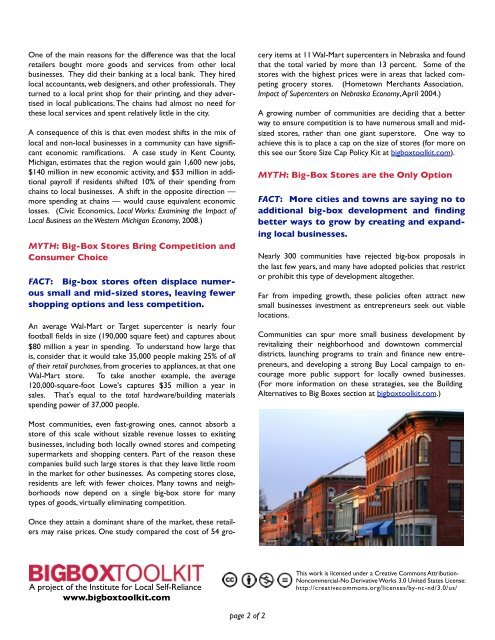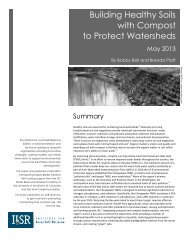Five Myths About Big-Box Retail - Institute for Local Self-Reliance
Five Myths About Big-Box Retail - Institute for Local Self-Reliance
Five Myths About Big-Box Retail - Institute for Local Self-Reliance
Create successful ePaper yourself
Turn your PDF publications into a flip-book with our unique Google optimized e-Paper software.
One of the main reasons <strong>for</strong> the difference was that the local<br />
retailers bought more goods and services from other local<br />
businesses. They did their banking at a local bank. They hired<br />
local accountants, web designers, and other professionals. They<br />
turned to a local print shop <strong>for</strong> their printing, and they advertised<br />
in local publications. The chains had almost no need <strong>for</strong><br />
these local services and spent relatively little in the city.<br />
A consequence of this is that even modest shifts in the mix of<br />
local and non-local businesses in a community can have significant<br />
economic ramifications. A case study in Kent County,<br />
Michigan, estimates that the region would gain 1,600 new jobs,<br />
$140 million in new economic activity, and $53 million in additional<br />
payroll if residents shifted 10% of their spending from<br />
chains to local businesses. A shift in the opposite direction —<br />
more spending at chains — would cause equivalent economic<br />
losses. (Civic Economics, <strong>Local</strong> Works: Examining the Impact of<br />
<strong>Local</strong> Business on the Western Michigan Economy, 2008.)<br />
MYTH: <strong>Big</strong>-<strong>Box</strong> Stores Bring Competition and<br />
Consumer Choice<br />
FACT: <strong>Big</strong>-box stores often displace numerous<br />
small and mid-sized stores, leaving fewer<br />
shopping options and less competition.<br />
An average Wal-Mart or Target supercenter is nearly four<br />
football fields in size (190,000 square feet) and captures about<br />
$80 million a year in spending. To understand how large that<br />
is, consider that it would take 35,000 people making 25% of all<br />
of their retail purchases, from groceries to appliances, at that one<br />
Wal-Mart store. To take another example, the average<br />
120,000-square-foot Lowe's captures $35 million a year in<br />
sales. That's equal to the total hardware/building materials<br />
spending power of 37,000 people.<br />
Most communities, even fast-growing ones, cannot absorb a<br />
store of this scale without sizable revenue losses to existing<br />
businesses, including both locally owned stores and competing<br />
supermarkets and shopping centers. Part of the reason these<br />
companies build such large stores is that they leave little room<br />
in the market <strong>for</strong> other businesses. As competing stores close,<br />
residents are left with fewer choices. Many towns and neighborhoods<br />
now depend on a single big-box store <strong>for</strong> many<br />
types of goods, virtually eliminating competition.<br />
Once they attain a dominant share of the market, these retailers<br />
may raise prices. One study compared the cost of 54 gro-<br />
A project of the <strong>Institute</strong> <strong>for</strong> <strong>Local</strong> <strong>Self</strong>-<strong>Reliance</strong><br />
www.bigboxtoolkit.com<br />
page 2 of 2<br />
cery items at 11 Wal-Mart supercenters in Nebraska and found<br />
that the total varied by more than 13 percent. Some of the<br />
stores with the highest prices were in areas that lacked competing<br />
grocery stores. (Hometown Merchants Association,<br />
Impact of Supercenters on Nebraska Economy, April 2004.)<br />
A growing number of communities are deciding that a better<br />
way to ensure competition is to have numerous small and midsized<br />
stores, rather than one giant superstore. One way to<br />
achieve this is to place a cap on the size of stores (<strong>for</strong> more on<br />
this see our Store Size Cap Policy Kit at bigboxtoolkit.com).<br />
MYTH: <strong>Big</strong>-<strong>Box</strong> Stores are the Only Option<br />
FACT: More cities and towns are saying no to<br />
additional big-box development and finding<br />
better ways to grow by creating and expanding<br />
local businesses.<br />
Nearly 300 communities have rejected big-box proposals in<br />
the last few years, and many have adopted policies that restrict<br />
or prohibit this type of development altogether.<br />
Far from impeding growth, these policies often attract new<br />
small businesses investment as entrepreneurs seek out viable<br />
locations.<br />
Communities can spur more small business development by<br />
revitalizing their neighborhood and downtown commercial<br />
districts, launching programs to train and finance new entrepreneurs,<br />
and developing a strong Buy <strong>Local</strong> campaign to encourage<br />
more public support <strong>for</strong> locally owned businesses.<br />
(For more in<strong>for</strong>mation on these strategies, see the Building<br />
Alternatives to <strong>Big</strong> <strong>Box</strong>es section at bigboxtoolkit.com.)<br />
This work is licensed under a Creative Commons Attribution-<br />
Noncommercial-No Derivative Works 3.0 United States License:<br />
http://creativecommons.org/licenses/by-nc-nd/3.0/us/





